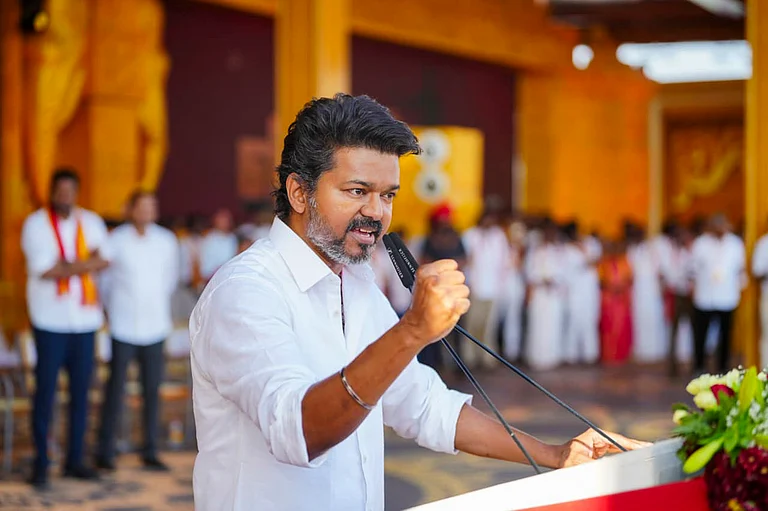Italian Prime Minister Giorgia Meloni told Chinese Premier Li Qiang that Italy is going to exit China's Belt and Road Initiative (BRI), according to reports.
The report comes after Meloni met Qiang on the sidelines of the G20 Summit in Delhi. The Meloni-Qiang meeting as well as the reports of impending exit from BRI come a day after the launch of India-Middle East-Europe Economic Corridor (IMEC), of which Italy is a member.
The BRI is the flagship infrastructure initiative of China under which it has undertaken a series of mammoth projects across the world, ranging from roads and railways to ports. The BRI, which is part of the Chinese campaign to emerge as the world leader, has been criticised over the years for plunging host countries into debt traps and creating infrastructure projects that have little value.
Italy was the only country from the G7 (Group of 7) to join China's BRI. The first signals that Meloni's government could withdraw from it came in July.
Here we explain what the reports say about Italy's withdrawal from BRI, what BRI is, and why it is criticised.
Italy could exit 'atrocious', 'wicked' BRI: Reports
Italian Prime Minister Giorgia Meloni on Sunday told her Chinese counterpart Li Qiant that her government would withdraw from China's BRI, according to reports.
While Italy withdraws from the BRI, it would instead work on the broader economic relationship with China, according to Reuters.
"Italy, seeking to minimise any backlash from the decision [to leave BRI] from Beijing, would as a replacement aim to revitalise a strategic partnership agreement with China, aimed at fostering economic cooperation, it first signed in 2004," reported Reuters.
Meloni and Qiant met in Delhi on the sidelines of the G20 Summit. Italy had joined the BRI under a previous government in 2019. Meloni has termed the BRI as "serious mistake".
Earlier in July, Italy's Defence Minister Guido Crosetto described the decision to join the BRI as "atrocious". He further said that while Italy exported next to nothing to China, imports from China flooded Italy.
"The choice to join the Silk Road was an improvised and wicked act, made by Giuseppe Conte's government, which led to a double negative result. We exported a load of oranges to China, they tripled their exports to Italy in three years. The most ridiculous thing at the time was that Paris, without signing any treaty, sold planes to Beijing for tens of billions in those days," said Crosetto in the interview to Corriere della Sera newspaper, according to a translation.
Crosetto said that the focus is on withdrawing from China but also not damaging the relations.
"The theme today is: retracing our steps without damaging relationships. Because it is true that China is a competitor, but it is also a partner," said Crosetto.
What is China's Belt and Road Initiative (BRI)?
The Belt and Road Initiative (BRI) is China's infrastructure project to connect the world with China through a network of roadways, shipping lanes, ports, railways, adn associated infrastructure.
The BRI was launched in 2013 and is the brainchild of Chinese President Xi Jinping, under whom China has embarked on a path to achieve global dominance by displacing the United States from the apex position in world affairs.
The BRI is also referred to as the New Silk Road as the BRI seeks to recreate the ancient route. The original Silk Road was a network of trade routes through Central, South, and East Asia that were in use for around 1,500 years.
The National Geographic Society notes, "The Silk Road is neither an actual road nor a single route. The term instead refers to a network of routes used by traders for more than 1,500 years, from when the Han dynasty of China opened trade in 130 B.C.E. until 1453 C.E., when the Ottoman Empire closed off trade with the West...The Silk Road extended approximately 6,437 kilometers (4,000 miles) across some of the world’s most formidable landscapes, including the Gobi Desert and the Pamir Mountains."
The BRI is also seen as part of Xi's agenda of restoring China to its former glory through increased trade and influence.
"Xi’s vision included creating a vast network of railways, energy pipelines, highways, and streamlined border crossings, both westward—through the mountainous former Soviet republics—and southward, to Pakistan, India, and the rest of Southeast Asia...In addition to physical infrastructure, China has funded hundreds of special economic zones, or industrial areas designed to create jobs, and encouraged countries to embrace its tech offerings, such as the 5G network powered by telecommunications giant Huawei," notes Council on Foreign Affairs (CFR).
The CFR notes that a total of 147 countries have signed up for BRI and China has so far spent up to $1 trillion on the project, with estimates saying total spending could reach up to $8 trillion.
The criticism, concerns regarding China's Belt and Road Initiative
The Chinese Belt and Road Initiative (BRI) is criticised primarily for roping in developing countries in large projects that their small economies cannot sustain, thus plunging these countries into debt traps.
Then, there is the issue of geopolitical influence-peddling and influx of Chinese nationals in local communities that lead to local opposition at times.
Broadly, the Chinese BRI projects are seen as being predatory in nature where China draws the bulk of benefits and host and partner nations are left with next to nothing. The reasons for such perception being that the vast bulk of financing comes from Chinese state-owned banks and the terms are such that China can seek repayment anytime. Contracts are also largely awarded to Chinese firms and are executed largely by Chinese companies and workers, leading to situations where promise of local employment-generation are not realised.
Moreover, Chinese projects under BRI are of 'dual nature' where China is suspected to be building infrastructure that can be activiated in future for military use. This is a cause of concern, particulary for India, as most South Asian countries are part of BRI and host such infrastructure.
"Beijing’s approach seeks to lay the groundwork for military utilization without raising red flags. Many BRI ports are built along a 'port-parks-city' development model that integrates the port with industrial parks and support industries like shipbuilding and resupply services that enhance the port’s capacity to support Chinese vessels, including navy ships," notes a study by Asia Society Policy Institute (ASPI).
The ASPI study further notes, "China is not building overseas naval bases but instead is developing ports with dual-use functionality from the South China Sea into the Indian Ocean and on to the Middle East. These ports are “Strategic Strongpoints” in close proximity to maritime chokepoints and critical sea lanes. They are designed to support the Chinese military’s logistics network and improve its ability to operate further from home."
While these concerns are mostly rooted in strategic reasons of China building a network of strategic and militarily significant ports and projects in the garb of economic projects, there is valid criticism with regard to partner countries too. After BRI partner Sri Lanka could not repay the Chinese loans for Hambantota port, China took the port on a 99-year-lease.
"While the BRI provides vital infrastructure funding to developing countries, it also leaves many with unsustainable debt. For example, China is funding a high-speed rail line in Laos that will cost equivalent to half the country’s GDP," notes Center for Strategic and International Studies (CSIS).
The CSIS further notes that eight BRI recipient countries —Djibouti, Kyrgyzstan, Laos, the Maldives, Mongolia, Montenegro, Pakistan, and Tajikistan— are at a high risk of debt distress due to BRI loans as their debt-to-GDP ratios are at risk of rising beyond 50 per cent. The think tank notes that, once BRI lending is complete, at least 40 per cent of their total external debt could be owed to China.
Such acute debt distress could plunge these countries into a cycle of loans where they need loans to pay loans. The other choice would be to surrender the assets built to China like Sri Lanka's case.


























